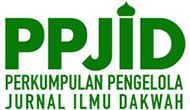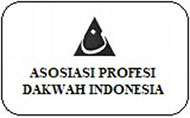Fenomena Cyber Religion sebagai Ekspresi Keberagamaan di Internet pada Komunitas Shift (Cyber Religion Phenomenon as a Religious Expression on the Internet in the Shift Community)
Abstract
Keywords
Full Text:
PDFReferences
Abdurrahman, M. S. (2020). Generasi Muda , Agama Islam , dan Media Baru : Perilaku Keagamaan Gerakan Shift Pemuda Hijrah Bandung. Jurnal Anida:Aktualisasi Nuansa Ilmu Dakwah), 20(1), 46–63.
Ahmad, A. (2014). Dinamika Komunikasi Islami di Media Online. Jurnal Ilmu Komunikasi, 11(April), 44–58. Retrieved from http://jurnal.upnyk.ac.id/index.php/komunikasi/article/download/308/262
Ardinal. (2014). Paradigma dan Model Penelitian Komunikasi (Cet.ke-1). Jakarta: Bumi Aksara.
Arifuddin. (2016). Dakwah Through Internet: Challenges and Opportunities for Islamic. Ar-Raniry: International Journal of Islamic Studies, 3(2), 118–129.
Asosiasi Penyelenggara Jaringan Internet Indonesia. (2020). Jumlah Pengguna Internet di Indonesia pada Kuartal ke-II. Jakarta. Retrieved from https://apjii.or.id/survey
Aziz, M. A. (2016). Ilmu Dakwah. Jakarta: Kencana.
Bagdikian, B. H. (2004). The New Media Monopoly: A Completely Revised and Updated Edition With Seven New Chapters (20th ed). USA: Beacon Press.
Bungin, B. (2007). Penelitian Kualitatif : Komunikasi, Ekonomi, Kebijakan Publik, dan Ilmu Sosial Lainnya (Edisi Ke-2). Jakarta: Kencana Prenada Media Group.
Data Dokumentasi Youtube Pemuda Hijrah. (2017). Retrieved 12 August 2020, from https://www.youtube.com/channel/UCVes0G5DqPa3ZHPL4W2OrhA
Data Observasi Website Pemuda Hijrah. (2017). Retrieved 1 July 2021, from https://pemudahijrah.id/
Dawson, L. L., & Cowan, D. E. (2004). Religion Online: Finding Faith on the Internet (1st editio). London: Routledge.
Denzin, N. K., & Yvonna S, L. (2009). Handbook Of Qualitative Research (Terjemahan Dariyatno). Yogyakarta: Pustaka Pelajar.
Devi, N. R. (2019). Moslem Missionary Communication of Pemuda Hijrah. Jurnal Manajemen Komunikasi, 3(2), 173–184.
Fakhruroji, M. (2017). Dakwah di Era Media Baru: Teori dan Aktivisme Dakwah di Internet. Bandung: Simbiosa Rekatama Media.
Farchan, Y. (2020, July). Islam Virtual Milenial Muslim Urban Indonesia. Retrieved 12 September 2020, from https://www.timesindonesia.co.id/read/news/288245/islam-virtual-ekspresi-keagamaan-milenial-muslim-urban-indonesia
Gary R, B. (2009). iMuslim: Rewiring the House of Islam (Islamic Ci). United States: University of North Carolina.
Hamali, S. (2016). Karakteristik Keberagaman Remaja Dalam Perspektif Psikologi. Jurnal Al-Adyan: Studi Lintas Agama, 11(1), 1–18. Retrieved from http://103.88.229.8/index.php/alAdyan/article/view/1438
Hasan, N. (2019). Ulama dan Negara-Bangsa: Membaca Masa Depan Islam Politik di Indonesia (Cet.1). Yogyakarta: Pusat Peb=ngkajian Islam, Demokrasi, dan Perdamaian (PusPIDeP).
Helland, C. (2007). Diaspora on the Electronic Frontier : Developing Virtual Connections with Sacred Homelands. Journal of Computer-Mediated Communication, 12, 956–976. doi:10.1111/j.1083-6101.2007.00358.x
Ilaihi, W., & Andriyani, K. (2010). Komunikasi Dakwah (Cet-2). Bandung: Remaja Rosdakarya.
Iqbal, A. M. (2016). Cyber-Religion and the Secularization Thesis. Jurnal Komunikasi Islam, 6(1), 1–28.
Ishanan, I. (2017). Dakwah di Era Cyberculture: Peluang dan Tantangan. Jurnal Komunike, 9(2), 91–104.
Jinan, M. (2013). Intervensi New Media dan Impersonalisasi Otoritas Keagamaan di Indonesia. Jurnal Komunikasi Islam, 3(2), 311–348. doi:https://doi.org/10.15642/jki.2013.3.2.%p
Kemp, S. (2020). Digital 2020: 3.8 Billion People Use Social Media. Retrieved from https://wearesocial.com/blog/2020/01/digital-2020-3-8-billion-people-use-social-media
Khalida Yusria, & Komariah, K. (2018). Transformasi Identitas Anggota Gerakan Pemuda Hijrah (Studi Fenomenologi Tentang Perubahan Pola Komunikasi dan Citra Diri Anggota Gerakan Pemuda Hijrah). Jurnal Riset Komunikasi, 9(1), 34–52. Retrieved from http://jurnal.untirta.ac.id/index.php/JRKom/issue/viewIssue/589/121
Khoiruzzaman, W. (2016). Urgensi Dakwah Media Cyber Berbasis Peace Journalism. Jurnal Ilmu Dakwah, 36(2), 316–334. doi:DOI:http://dx.doi/10.21580/jid.36i.2.1775
Malik, H. (2021). Cyber Religion dan Real Religion di tengah Masyarakat Digital. Jurnal Komunika, 4(1), 63–78. doi:https://doi.org/10.24042/komunika.v4i1.8615
Mazaya, V. (2019). Cyberdakwah Sebagai Filter Penyebaran Hoax. Islamic Communication Journal, 4(1), 14–25.
Nawawi, H. (1998). Metode Penelitian Bidang Sosial. Yogyakarta: Gajahmada Universitas Press.
Nur, S., & Abdullah, I. bin. (2014). The Implication of Excessive Internet Usage on the Study of Hadith. Journal of Islam in Asia, 10(2), 118. doi:10.31436/jia.v10i2.398
Possamai, A. (2005). Religion and Popular Culture : A Hyper-Real Testament. Brussels: P.I.E.-Peter Lang.
Raco, J. (2010). Metode Penelltlan Kualltatlf Jenis, Karakteristik, dan Keunggulannya. Jakarta: Grasindo.
Rumadi. (2012). Islam dan Otoritas Keagamaan. Jurnal Studi Komunikasi, 20((1)), 25–54.
Saefulloh, A. (2012). Cyberdakwah sebagai Media Alternatif Dakwah. Jurnal Islamica: Jurnal Studi Keislaman, 7(1), 138–160. doi:https://doi.org/10.15642.islamica.2012.7.1.138-160
Salman, Y. (2015). Dakwah di Internet : Konsep Ideal , Kondisi Objektif dan Prosfeknya. Jurnal Al-Bayan, 22(31), 56–70.
Setiansah, M. (2015). Smartphonisasi Agama: Transformasi Perilaku Beragama Perempuan Urban Di Era Digital. Jurnal Komunikasi, 10(1), 1–10. doi:10.20885/komunikasi.vol10.iss1.art1
Sugiyono. (2017). Metode Penelitian Kuantitatif, Kualitatif dan R&D (Cet ke-26). Bandung: Alfabeta.
Taufik, M., & Taufik, A. (2020). Hijrah and Pop Culture: Hijab and Other Muslim Fashions Among Students in Lombok, West Nusa Tenggara. Teosofia, 8(2), 97–116. Retrieved from http://journal.walisongo.ac.id/index.php/teosofia/article/view/5305
Wibowo, A. (2019). Penggunaan Media Sosial sebagai Trend Media Dakwah Pendidikan Islam di Era Digital. Jurnal Islam Nusantara, 3(2), 339–356. Retrieved from http://www.jurnalnu.com/index.php/as/article/view/141
Zahara, M. N., Wildan, D., & Komariah, S. (2020). Gerakan Hijrah: Pencarian Identitas Untuk Muslim Milenial di Era Digital. Indonesian Journal of Sociology, Education, and Development, 2(1), 52–65. doi:10.52483/ijsed.v2i1.21
Zaini, A. (2012). Dakwah Melalui Internet. Jurnal At-Tabsyir: Jurnal Komunikasi Penyiaran Islam, 1(1), 93–108.
DOI: http://dx.doi.org/10.24014/jdr.v32i1.11626
Refbacks

This work is licensed under a Creative Commons Attribution-ShareAlike 4.0 International License.
Editorial Office:
2nd Floor, Building of Faculty of Da'wah and Communication, Universitas Islam Negeri Sultan Syarif Kasim Riau. Jl. HR Soebrantas Km 15, Simpangbaru, Tampan, Pekanbaru
Email : jurnalrisalah@uin-suska.ac.id

This work is licensed under a Creative Commons Attribution-ShareAlike 4.0 International License.














